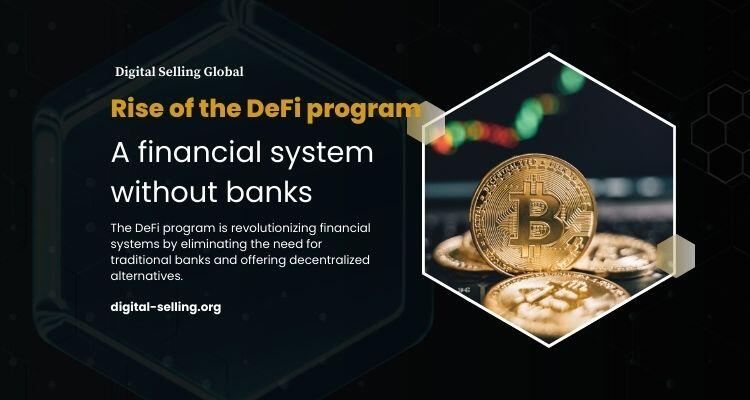The DeFi program is revolutionizing financial systems by eliminating the need for traditional banks and offering decentralized alternatives.
The Evolution of the DeFi Program
The DeFi program, or decentralized finance, has rapidly gained traction in the financial sector, challenging the traditional banking system by leveraging blockchain technology. Originating from the advent of Bitcoin in 2009, DeFi has evolved significantly, aiming to create a more inclusive and transparent financial ecosystem. Unlike traditional finance, which relies on centralized institutions such as banks and brokers. The DeFi program operates on decentralized networks, primarily using smart contracts on the Ethereum blockchain.
Core Principles of the DeFi Program
At the heart of DeFi are several core principles: decentralization, transparency, and accessibility. Decentralization means that no single entity controls the network, reducing the risk of corruption and failure. Transparency is achieved through the public nature of blockchain, where all transactions are recorded and visible to anyone. Accessibility ensures that anyone with an internet connection can participate in financial activities without the need for intermediaries like banks.
Key Components of the DeFi Program
- Smart Contracts: These self-executing contracts with the terms of the agreement directly written into code are fundamental to the DeFi program. They enable trustless transactions and automate processes, reducing the need for human intervention.
- Decentralized Exchanges (DEXs): Platforms like Uniswap and SushiSwap allow users to trade cryptocurrencies directly with one another without relying on a centralized exchange. This not only increases security but also offers greater control over one’s assets.
- Lending and Borrowing Platforms: Services such as Aave and Compound enable users to lend their cryptocurrencies to others or borrow against their holdings, earning interest or accessing liquidity without traditional credit checks.
- Stablecoins: Cryptocurrencies like DAI and USDC are pegged to stable assets like the US dollar, offering a reliable store of value and medium of exchange within the DeFi platform. These reduce the volatility typically associated with cryptocurrencies.
- Yield Farming and Liquidity Mining: These innovative concepts allow users to earn rewards by providing liquidity to DeFi platforms. Yield farmers can earn returns by locking up their crypto assets in liquidity pools, while liquidity mining often rewards participants with governance tokens.
Advantages of the DeFi Program
The DeFi program offers numerous advantages over traditional financial systems. It provides financial services to the unbanked and underbanked populations worldwide, who often lack access to conventional banking. The programmability of money through smart contracts allows for the creation of complex financial instruments without the need for intermediaries, reducing costs and increasing efficiency. Moreover, DeFi fosters innovation, as developers can build on existing protocols, creating a diverse ecosystem of interoperable financial products.
Challenges and Risks
Despite its potential, the DeFi program faces several challenges and risks. Security is a primary concern, as vulnerabilities in smart contracts can be exploited by hackers, leading to significant financial losses. The lack of regulatory oversight can also be problematic, as it may attract illicit activities and scams. Additionally, the complexity of DeFi products can be a barrier to entry for new users, necessitating better educational resources and user-friendly interfaces.
Regulatory Landscape
The regulatory landscape for the DeFi program is still evolving. Governments and regulatory bodies are grappling with how to address this new financial paradigm. Some regions are taking a proactive approach, implementing regulations to protect consumers and ensure the integrity of financial markets. Others are adopting a more cautious stance, observing the development of the DeFi program before formulating policies. The challenge for regulators is to strike a balance between fostering innovation and ensuring consumer protection and financial stability.
The Future of the DeFi Program
The future of DeFi looks promising, with continuous advancements and increasing adoption. As blockchain technology matures and becomes more scalable, DeFi is likely to attract more users and capital. Integration with traditional finance, such as through the tokenization of real-world assets. This could further bridge the gap between decentralized and centralized systems. Additionally, improvements in security protocols and regulatory clarity will help mitigate risks, making the DeFi program more robust and trustworthy.
Conclusion
The DeFi program represents a paradigm shift in the financial world, offering a decentralized alternative to traditional banking systems. By leveraging blockchain technology and smart contracts, the DeFi provides transparency, accessibility, and efficiency. While challenges and risks remain, the potential benefits of a decentralized financial system are immense. As the DeFi program continues to evolve, it holds the promise of creating a more inclusive and innovative financial ecosystem, transforming the way we interact with money and finance.

